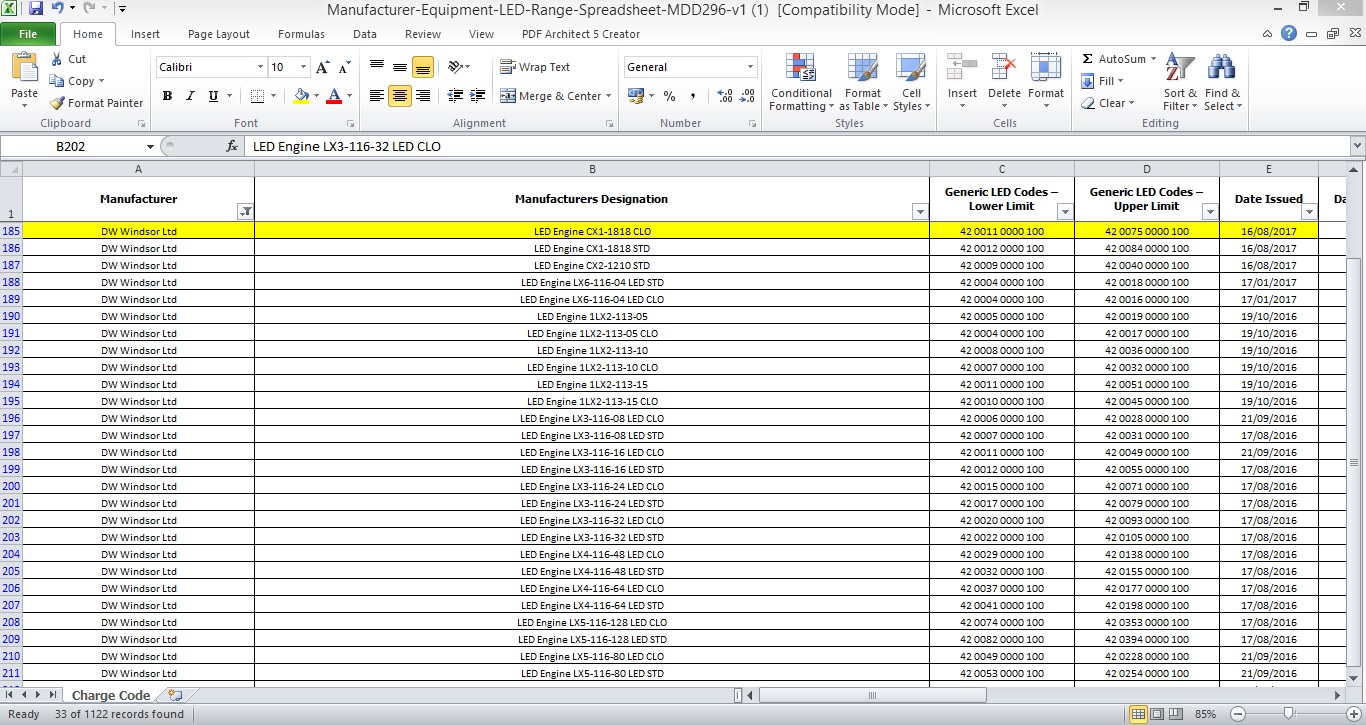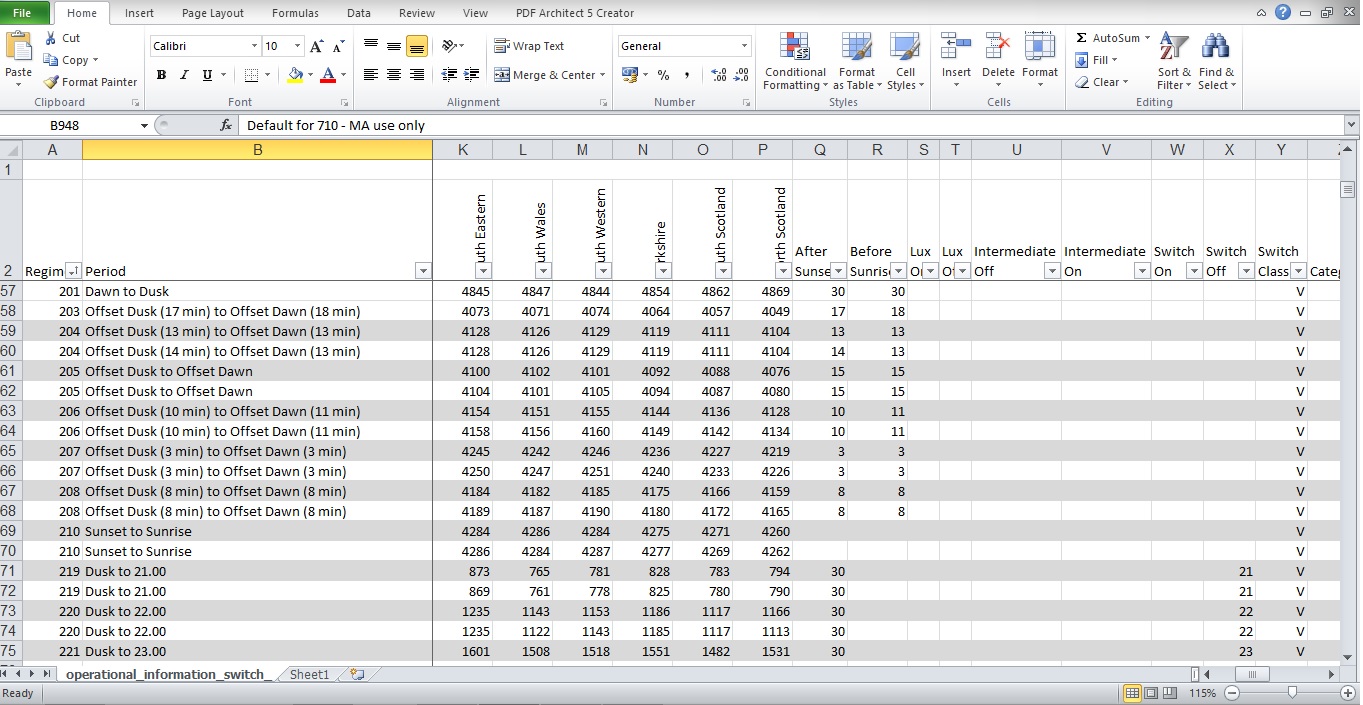Charge codes have been developed in order to calculate volumes of electricity consumed by individual items of electrical furniture or apparatus. This allows pieces of electrical furniture/apparatus to be unmetered i.e. no electric meter need be installed within the individual piece of apparatus. Instead 13 digit charge codes are specifically produced for individual pieces of electrical furniture/apparatus which are then assigned to a UMS Customers (Unmetered Supply Customers) inventory. This then allows customers equipment inventories, including the charge codes, to be issued to electricity providers where their UMSO systems calculate volumes of electricity consumed and then in turn allow UMS Customers electricity bills to be calculated.

How does this all relate to the street lighting industry?
Essentially all newly proposed and installed street lighting luminaires, illuminated signs and illuminated bollards will have a charge code. Charge codes are also assigned for the lighting control type, i.e. photocell. So if you are a developer and have a Section 278 or Section 38 street lighting design, with lighting equipment being proposed for adoption by a local authority, you will inevitably be asked at some point for the charge codes of the electrical apparatus on the lighting design drawing.
How do you go about finding a charge code for the equipment on your street lighting design?
You will find a link below to an organisation called Elexon and their specific Microsoft Excel spreadsheet. Essentially Elexon are responsible for the administration of the electrical furniture/apparatus manufacturer’s application process and are also responsible for issuing charge codes for furniture/apparatus. The Microsoft Excel spreadsheet on the link details all the most commonly used pieces of electrical street lighting apparatus. By the use of the filters on the spreadsheet, you will be able to find specific 13 digit charge codes for individual luminaires, photocells and other popular pieces of electrical equipment. A section 38 lighting design or section 278 lighting design may require charge codes to complete the energy supply ordering process.
https://www.elexon.co.uk/wp-content/uploads/2020/04/Unmetered-Supplies-Operational-Charge-Codes-MDD296-v2.xls
What do the 13 digits on a charge code mean?
Example charge code: 42 0064 0000 100
42 = Designates the lamp type. The number 42 is a generic code designated to an LED product.
0064 = Designates the power consumption of the specific apparatus, measured in watts.
0000 = Designates a generic code which is generally 0000, as the figure relates to the control gear type.
100 = Designates the light output, so in this instance it’s 100% output, with no dimming regime applied to the light output at any time during the light being functional and on.
Does my charge code change if a dimming regime is applied?
If the furniture/apparatus has a pre-set dimming value, this number will vary depending upon what the unit is dimmed by. The example shown above does not dim and therefore is set at 100% output and is shown in the code as 100. It should be noted if the furniture/apparatus is controlled via a Central Management System (known as CMS) and dimmed through that specific CMS system, the dimming value will remain at 100 even though it is dimmed. CMS reporting function, via the event log of your CMS system, will then determine the energy consumption and this is then provided to the appropriate Meter Administrator.
By linking the charge codes that are published on the Elexon’s website with an alpha-numeric Variable Power Switch Regimes (also published on the site), dimming of generic LED charge codes (42 charge codes as detailed above) can be accommodated. However, as noted above, if the furniture/apparatus is controlled via a CMS system and dimmed through that specific CMS system, then a Variable Power Switch Regime is not required. As the CMS reporting function, via the event log of your CMS system, will then determine the energy consumption and this is then provided to the appropriate Meter Administrator.

Does a luminaire with Constant Light Output (CLO) affect the charge code?
If a luminaire has CLO, then the lighting manufacturer will specify the ‘mid-life’ value of the energy consumption for the product. This figure will then be used in the power consumption element of the charge code, so the second four digits of your charge code. To demonstrate an example of this, if the ‘mid-life’ value for an LED street light is 46 watts, then the manufacturer should declare the generic LED Charge Code to the customer as 42 0046 0000 100.
What is a Switch Regime?
A Switch Regime is a three digit numeric/alpha-numeric code that is applied to any piece of furniture/apparatus that is connected to an Unmetered Supply. The switch regime identifies the number of hours that the furniture/apparatus is to be operational. It also details the on/off times of the furniture/apparatus. Switch regimes and charge codes go hand in hand and are used together to inform your and Meter Administrator how much energy is being consumed on your network. Switch Regimes are also administered and issued by Elexon and all details of the application process can be found on Elexon’s website.
Where can I find the appropriate Switch Regime digits for my equipment?
Elexon have published a Microsoft Excel spreadsheet on the on their website that details all the most commonly used switch regimes. By the use of the filters on the spreadsheet, you will be able to find the specific 3 digit code for your individually set burning hours.
Which websites will assist me with Charge Codes and Switch Regimes?
Most industry recognised lighting manufacturers will provide a lot of the information that you require on their own websites. Companies such as DW Windsor and Indo have links to the information that you will need on their websites.
Alternatively, if you head directly to Elexon’s website via the links below or via a search engine, you will be able to find the appropriate spreadsheets on their site and the information is easily extracted from there.
⦁ https://www.elexon.co.uk/operations-settlement/unmetered-supplies/charge-codes-and-switch-regimes/
⦁ https://www.ssen.co.uk/UnmeteredSupplies/
⦁ http://indolighting.com/
⦁ https://www.dwwindsor.com/
We hope that you have found this Blog informative and indeed helpful. If you would like to discuss your street lighting design project or development site with us, then please feel free to give us a call on 0118 321 5636. We will be more than happy to talk through the best lighting design approach and hopefully work with you to assist in gaining full planning permission and discharging any planning condition that you may have. Alternatively please send your enquiry to info@mma-consultancy.co.uk and we will get back to you as quickly as we possibly can.
